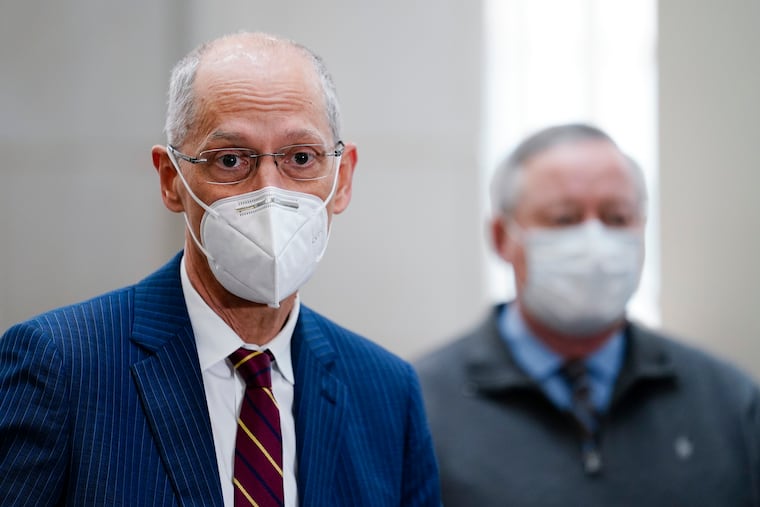It’s time to complete the overhaul of the Medical Examiner’s Office | Editorial
The mishandling of the remains of victims of the MOVE bombing underscored systemic problems in the office.

Mayor Jim Kenney was right when he forced the resignation of Philadelphia Health Commissioner Thomas Farley last year. Now, he must complete the task of overhauling the Medical Examiner’s Office.
Farley was ousted in the wake of the city’s outrageous mishandling of the remains of victims of the 1985 MOVE bombing, which sat in a box in the Medical Examiner’s Office for years. An independent investigation concluded that the Medical Examiner’s Officer was also awash in widespread systemic problems.
For starters, the office is woefully understaffed, and it had no written policies. Unlike most major cities, Philadelphia’s Medical Examiner’s Office isn’t accredited by a professional organization, which would help ensure basic quality standards.
New leadership and increased staffing is a must. The Medical Examiner’s Office performed 1,721 autopsies last year — an average of 240 per pathologist. That staffing shortage comes as the office struggles to keep pace with a rise in deaths from COVID-19, opioid overdoses, suicides, and a record number of murders.
» READ MORE: Philly’s medical examiner’s office is understaffed and struggling to investigate deaths. Fixing it might take years.
Philadelphia is not alone when it comes to some of these problems. Across the country, shoddy work by medical examiners has for years led to wrongful convictions and bungled prosecutions. A botched autopsy almost led to the wrongful murder conviction of a man in Tennessee. A North Carolina medical examiner misclassified one man’s accidental death as a suicide.
Such missteps lead to unsolved crimes and add trauma for loved ones at the worst possible time. The mishandling of the MOVE victims’ remains was a final insult in a debacle that has haunted the city for decades.
Farley’s resignation last year fittingly came on the 36th anniversary of the infamous day the city dropped a bomb on a rowhouse in West Philadelphia after a police standoff with members of a radical group known as MOVE.
The bomb sparked a fire that killed 11 people, including five children. City officials watched as the fire spread, destroying 61 homes in the mostly Black neighborhood.
» READ MORE: Systemic issues at Medical Examiner’s Office require firm response | Editorial
An independent commission’s report condemned city leaders for a plan that was “reckless, ill-conceived, and hastily approved.” A separate grand jury investigation criticized Mayor Wilson Goode, Police Commissioner Gregore J. Sambor, Fire Commissioner William C. Richmond, and former Managing Director Leo A. Brooks for “morally reprehensible behavior” and “an epic of governmental incompetence.” But no one was indicted.
The corrupt and shoddy rebuilding of homes in the bombed neighborhood compounded the tragedy of errors for residents and cost taxpayers tens of millions of dollars. It took 35 years before City Council passed a resolution apologizing for the city’s shameful actions.
It was disclosed last year that some remains from the bombing had been sitting for years in a box in the basement of the Medical Examiner’s Office. In 2017, Farley ordered the remains to be cremated and disposed of without telling family members, but his orders were inexplicably ignored.
Investigators from the two law firms that compiled the latest report were surprised by how many people they interviewed were not even aware of the bombing and called for a “concerted, inclusive effort to educate Philadelphians about the MOVE bombing.”
Even more disturbing, the investigators learned that the victims’ remains were mishandled from the start. Two days after the bombing, a crane used to clear debris damaged and commingled the badly burned remains. Initially, no one from the Medical Examiner’s Office was on the site and files relating to the victims are, according to the report, “incomplete, inconsistent and, at times, contradictory.”
The five children killed in the bombing were buried in unmarked graves — three in one grave and two in another in Eden Cemetery, where 19th century civil rights activist Octavius V. Catto and famed opera singer Marian Anderson are also interred.
The MOVE victims and their families have been failed for decades by city officials. By improving the Medical Examiner’s Office, the city can prevent future mishaps and ensure victims and their families receive the respect and dignity they deserve.